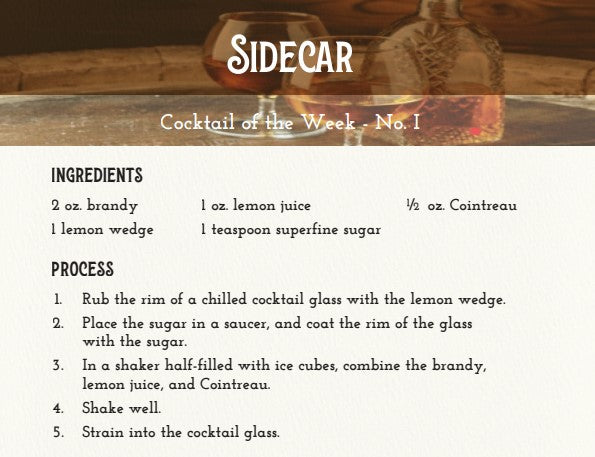Sidecar

Sidecar
The Sidecar cocktail was invented over a century ago in post-World War I Europe at either the Hotel Ritz in Paris or Buck's Club in London. Regardless of the city of origin, the cocktail was widely popular in Paris in the "Roaring Twenties", and was regularly enjoyed by world-renowned expatriate authors Ernest Hemingway and F. Scott Fitzgerald.
With its three simple (yet quality) ingredients, the Sidecar remains a crowd-pleaser today. A few tips:
Cognac vs. Brandy
While brandy is a general category of spirits made from a variety of distilled fruit, cognac is a premium brandy made (i) from white grapes, (ii) exclusively in the Cognac region of France, and (iii) aged a minimum of two years in oak barrels. For the best result, use your favorite cognac (and fresh-squeezed lemon juice) when preparing the Sidecar cocktail.
Grand Marnier vs. Cointreau
Some people consider Grand Marnier a premium version of Cointreau. In fact, both are premium orange-infused liqueurs made in France. One significant difference: Grand Marnier is made with cognac, which contributes to its velvety texture. The appropriate liqueur for the Sidecar cocktail, however, is Cointreau.
Note: If you're going to own a single liqueur, Cointreau is the one. It is the most common liqueur in a litany of classic cocktails, and an essential component of any home bar.
Literary Accompaniment
In addition to their well-known and widely-read novels, both Hemingway ("The Old Man and the Sea") and Fitzgerald ("The Great Gatsby") were brilliant authors of short stories. Two of my favorite books are "The Complete Short Stories of Ernest Hemingway: The Finca Vigia Edition" (Scribner) and "The Short Stories of F. Scott Fitzgerald" (Scribner). Make yourself a Sidecar, grab one of these books, and immerse yourself in great literature while sipping a classic cocktail that was enjoyed by both writers a century ago.
